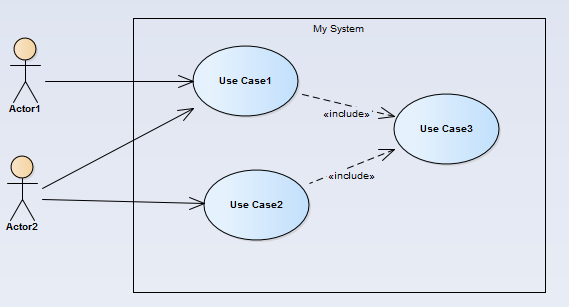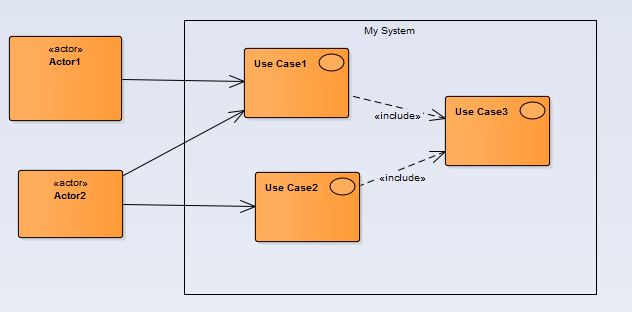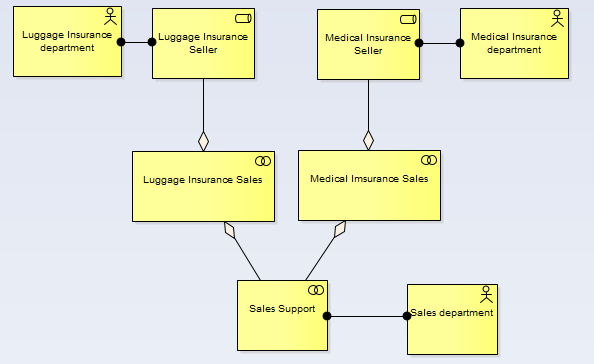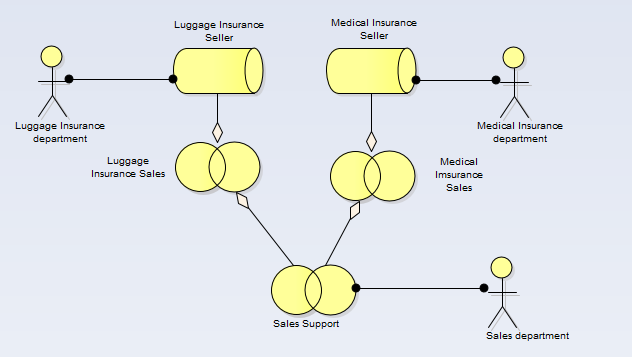Using UML icons for more useful models
Diagram Graphics for Adults
The UML language gives us some simple graphical elements to represent the key ideas.

or example, a UML Use Case diagram looks like this.
I find that diagrams like this really don’t need explaining, even to non-UML readers.
Maybe I might have to say that the blue oval is a ‘story’ of how something gets done, but the rest is fairly obvious:
- Some actors are involved in some Use Cases, and
- a couple of the Use Case include another one.
But you might not know that this use of these shapes is optional. UML also says we can use a simpler ‘rectangle’ notation if we want:
Using this notation style doesn’t seem quite as obvious. The tool which I used for the diagrams – EA – helpfully added some default colors to the diagram, which I have removed, just to make the point that I don’t think this diagram is anything like so immediate. A box which says <<Actor>> doesn’t seem so obvious as one which has a stick-person. Which is why I have never seen a UML Use Case diagram use the rectangle notation.

So why use Rectangles ?
This use of the simple rectangle notation is taken to the extreme by Archimate. Most examples from that language seem to use the rectangle notation exclusively, even when it might give the reader a clue as to what’s being modelled:

An Archimate example, taken from the Open Group specification for Archimate. They are saying that:
- There are three Business Actors: the luggage, medical insurance and sales department
- Two of them take the respective Business Roles of Luggage Insurance Seller and Medical Insurance
- There are some Business Collaborations, where these Roles and Collaborations get together to done something (not specified here)
The equivalent diagram using the non-rectangle notation looks like this:
I think that this diagram is easier to read than the one above. Apart from the disappointing visual pun of the ‘role (roll)’, the other two bits of notation seem sensible: the Business Actor looks like a person ,and “collaboration” as of two overlapping circles seems sensible.
I realize that in taking this view, I’m making myself into a “Mickey-mouse”, child-like modeller. Gerben’s book (Mastering Archimate) comes out really, really strongly against this notation style, and in favour of the simple rectangle:
“In my view, these forms are for children, not grown-ups..” and suggests that if I want to use this style, I should go the whole way and “..create a funny drawing with Greek columns, jumping dogs...” (you see, Gerben – I really DID read your book..:-) )

…which is a shame, because I really think that the more visual cues we give our readers, the easier they will find it to understand what we’re trying to say. Like Gerber, I believe PowerPoint and Visio, and especially ANY kind of clip-art are death to modeling, but these aren’t those kinds of random images: they are part of an industry-standard notation, which will be the same no matter who draws it.
Perhaps this is why I found Gerben’s book such a hard read. He does use a consistent color scheme for the Archimate layers, but uses the rectangle style for the boxes, which seems to make the diagrams very similar to each other. Even though they are saying very different things. And all the boxes are deliberately the same size, which means he can’t use the obvious abstraction of ‘big box = big thing’.
So i’m going to stick with my ‘child-like’ modelling, and use the non-rectangle notation.
I never wanted to be a adult anyway.
More Insights
Documents are dead - or are they?
19 October 2023
If your organization needs documents then you need eaDocX and Revision Manager - for quality documents, easy reviews and fast efficient model updates.
Learn MoreDocument-based EA model collaboration
27 September 2023
eaDocX and eaRevisionManager provide a cost effective and powerful solution for efficient document-based collaboration in Enterprise Architect.
Learn MoreWhy has eaDocX become eaTeamWorks?
27 September 2023
Here are the reasons why eaDocX is now part of eaTeamWorks - and why it's good for you.
Learn MoreCreating Custom Documents in Enterprise Architect 16
21 September 2023
Enterprise Architect 16 offers refined tools for customizable report-building. But sometimes you need even more. And fast. Here's how.
Learn MoreTraceability using Multi-hop Relationships
9 September 2021
Using eaDocX multi-hop relationships you can easily print the end points of 'virtual connectors' showing EA end-to-end traceability.
Learn MoreEnterprise Architect Tables: Using word table styles in EA
25 June 2021
This video shows how to apply Word table styles when you generate eaDocX documents from your Enterprise Architect models.
Learn MoreVideo Masterclass - Adding Detail to EA Matrix Reports with eaDocX
25 June 2021
With eaDocX you can format EA Matrix Reports in Word to include additional details and formatting. Here's how
Learn MoreVideo Masterclass - Creating documents from Model Views
25 June 2021
Use EA Model Views to create simple, flexible documents with eaDocX.
Learn MoreConditional Formatting Tool for Enterprise Architect
25 June 2021
Help readers find the things that need their attention, decisions and actions, with eaDocX conditional formatting.
Learn MoreVideo Masterclass - Attribute mapping with EA, eaDocX and Excel
25 June 2021
With eaDocX and Excel, it's easy to view, edit, create and even delete attribute/attribute links in Sparx EA.
Learn MoreEnterprise Architect Help: Choosing the right document structure
25 June 2021
eaDocX makes it easy to create exactly the document structure your readers need. Here's how...
Learn MoreEnterprise Architect User Guide - quick documents
22 June 2021
Video guides on how to create quick documents with EA's leading add-on, eaDocX.
Learn MoreDocuments in the Enterprise Architect Cloud
6 April 2021
eaDocX in the Cloud: Enterprise Architect document creating for EA SAAS environments
Learn MoreProducing Enterprise Architect RACI reporting
11 March 2021
Producing a RACI report from data held in EA, mapping stakeholders to any project deliverables is straightforward with eaDocX.
Learn MoreModels matter - nearly as much as deliverables
25 August 2020
Models matter - nearly as much as model deliverables
Learn MoreFixing your meta-model
25 August 2020
Advice for the new modeller #3 – Fixing your meta-model
Learn MoreKnowing when to give up
25 August 2020
Knowing when to step back makes for better Business Analysts
Learn MoreUsing Enterprise Architect to document decision making
25 August 2020
Make your models more useful for future modellers
Learn MoreExplaining EA Sparx Systems to non-modellers
25 August 2020
Model driven analysis - the best way to define what we do?
Learn MoreHow to simplify BPMN Data Models
25 August 2020
Why simplifying your diagrams can actually make them more informative.
Learn MoreUML Business Analyst Solutions
14 August 2020
Using UML to resolve inconsistencies, gaps and overlaps.
Learn MoreCleaning: How to Simplify Enterprise Architecture Models
14 August 2020
Model Curation Techniques # 1 - Cleaning your EA model before you let other people see it
Learn MoreIncluding Sparx EA Model Provenance
14 August 2020
Sparx EA model help to explain to others why your models look the way they do.
Learn MoreWhat to include in your Enterprise Architect documentation
29 July 2020
How to create documents which communicate your ideas efficiently and effectively to stakeholders.
Learn MoreOrganising an Enterprise Architect Model
28 July 2020
Seven ways to organise your EA models so that other people can understand them
Learn MoreChoosing Your UML Subset
27 July 2020
Narrowing down the modelling ideas in your Enterprise Architect model to make consistent, understandable models.
Learn MoreWebinar: Using Interactive Documents to Collate Sparx EA Model Feedback
17 July 2020
A webinar from the EA Global Summit 2020.
Learn MoreWebinar: How to successfully scale up your Enterprise Architect team
30 June 2020
A webinar from the EA Global Summit 2020.
Learn MoreNavigating Models: Enterprise Architect Help and Techniques
16 April 2020
EA Model Curation Techniques #2 - Making models easy to navigate.
Learn MoreValidation: Improving your Enterprise Architecture Model Structure
16 April 2020
EA Model Curation Techniques #3 - Validating your model
Learn MoreModelling techniques for business architecture software to explain general patterns
16 April 2020
Using object diagrams to explain general patterns with specifics.
Learn MoreHow to create personalised documents using Sparx document generation tools
16 November 2018
A guide to creating documents from Sparx EA models so everyone can engage with your work, project or deliverables.
Learn MoreDocument or Enterprise Architect Views?
21 May 2018
Create documents to be used by non-EA users instead of model views.
Learn MoreImprove your enterprise architecture model using colour
25 April 2018
Careful use of colour and shape makes models easier to digest.
Learn MoreModel curation techniques for EA Sparx Systems
6 March 2018
How cleaning, navigating and validating your EA model makes sharing and collaborating much more effective.
Learn MoreThe most re-used model components in Sparx Enterprise Architect.
20 October 2017
Why is the project summary the most read element in an EA model?
Learn MoreCreating a Glossary: Business Analyst Terminology
12 October 2017
Streamline your business understanding with shared definitions.
Learn MoreBusiness Process Analyst Styles
11 October 2017
Find out if you are a 'hard' or 'soft' Business Analyst.
Learn MoreHow to Print Sparx EA Connectors
18 October 2016
Structure your documents using the connectors in your Sparx model.
Learn MoreUsing Multi-hop relationships to display Branch/Merge with EA13
11 August 2016
One of the most common requests we see from new EA users is: "Why can’t I do branch/merge with EA?
Learn More